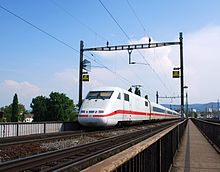Protection route

As neutral section is a transition piece is in contact lines designated, which serves to separate different feed portions from one another electrically. In contrast, system separation points are inserted between sections with different contact wire voltages and / or types of current , which require more effort.
Essence of a protective route

A neutral section consists of two consecutive short distance separations and at Deutsche Bahn m long rule 35, a shortened neutral section seven meters. Protective sections must be traveled with the main switch switched off, otherwise an arc will arise between the live contact wire and the pantograph pallet. The length of a classic protective route is designed in such a way that even when driving with two pantographs on a traction vehicle, there is no bridging by the vehicle's electrical system. The contact wire of the ending feed section is led up and away to the side. The pantograph can continue to run on the neutral section without losing contact with the contact wire until that of the following feed section is brought in from the side and from above (technical term: sliding ). The neutral section in between is tension-free when the protective section is open , so that the train continues to move due to its inertia . Protective sections of the standard design can be switched through and then driven on with the main switch switched on. They are then provided with adjustable contact line signals, the switch-off signal [in Germany El 1) in front of the protective section changes in this case to a switch-on signal El 2. If a train comes to a standstill in an effective protective section, the contact wire section can be switched on.
Shortened protective lines on railroads consist of two line separators following each other at short intervals with a neutral contact wire section in between. This cannot be switched on as an alternative. They would be bridged by locomotives with two pantographs, so they are not allowed to be driven on. If it is not possible to lower a pantograph, iron must be completely ironed in front of the protective section. Such shortened power lines were introduced at the ÖBB from 1970, at the German railways a few years later. If a traction vehicle comes to a standstill in a shortened protective route, the journey can be continued with the second pantograph, if one is available.
At the beginning of electrification, protective routes in Germany had lengths of up to 180 meters and were divided into several fields that could be switched on individually.
In the case of railways electrified with busbars , protective routes consist of busbar gaps that are longer than the greatest possible distance between pantographs connected to one another.
Signaling
In Germany and Austria, the beginning of a protective route is signaled with signal El 1 (switch-off signal ) and the end with El 2 (switch-on signal ) (→ contact line signal ). The beginning of the protective section is indicated with an interrupted U, the end with a continuous U. The symbol is white on a blue background. The same symbol is used in Switzerland, but it's black on a yellow background.
See also
Individual evidence
- ↑ Helmut Pretrovitsch: Borderline case protection route. In. eisenbahn-magazin issue 5, 2014, p. 27
- ↑ Swiss Driving Regulations (FDV) A2016 Federal Office of Transport (FOT), July 1, 2016 (PDF; 3 MB). R 300.2, section 7.1.3 Signals for protective routes



